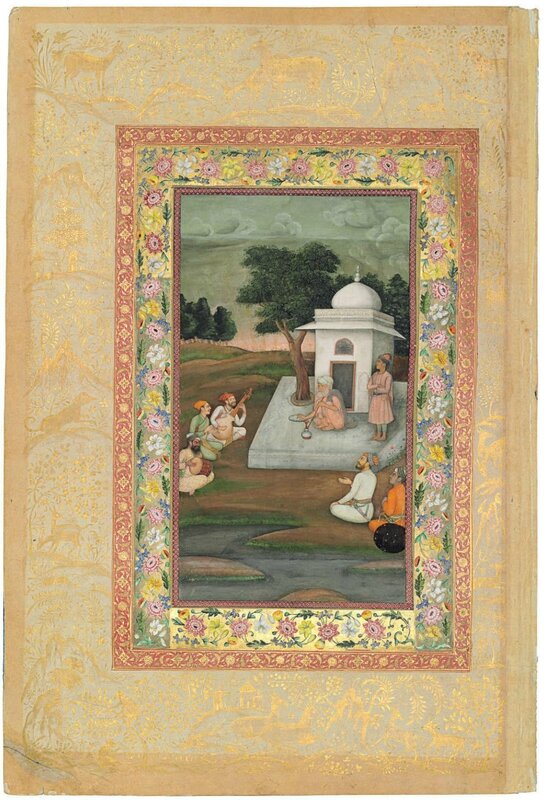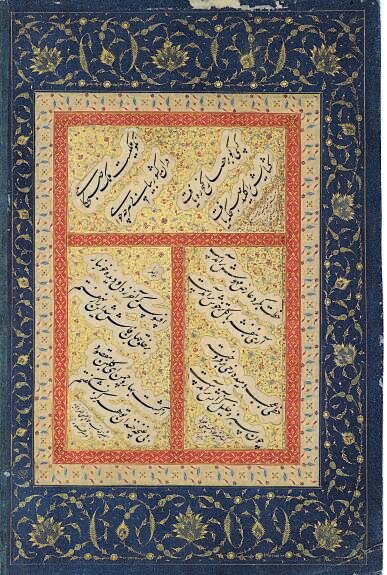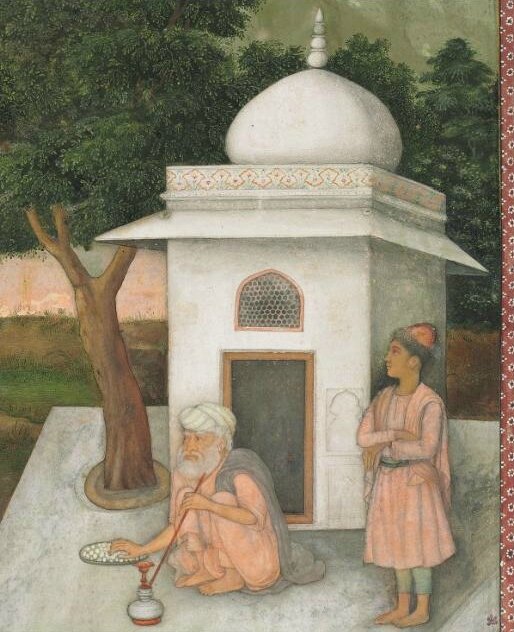A prince visits a sufi shaykh at dawn
Lot 19. A prince visits a sufi shaykh at dawn. The painting possibly attributable to Bichitr, Mughal India, mid 17th century, the calligraphy signed 'Imad Al-Hassani, Safavid Iran, late 16th-early 17th century, the borders signed Muhammad Hadi, Iran, dated AH 1171/1757-58 AD. Estimate £80,000 - £120,000 ($113,760 - $170,640). Price Realized £134,500 ($191,259). Photo Christie's Image 2016
Opaque pigments heightened with gold on paper, a Prince and his attendant pay respects to a Sufi Shaykh and his novice at a shrine at dawn, musicians to the left, extended at top and bottom, within gold and polychrome minor floral borders, on wide margins with gold landscape scenes containing a wide variety of animals and European-style architecture, the calligraphy on the reverse composed of three panels each with 4ll. of black nasta'liq in white clouds reserved against gold illuminated ground, each panel signed and bordered by bands of strapwork, the margins with gold scrolling arabesques issuing large palmettes on blue ground, signed and dated in the lower left hand corner. Painting 9 5/8 x 5½in. (24.6 x 14cm.); calligraphy 11 x 8in. (28 x 20.4cm.); folio 18¾ x 12 7/8in. (47.6 x 32.8cm.)
A FOLIO FROM THE ST. PETERSBURG MURAQQA'
Notes: The Album:
It is believed that the Indian paintings from the album now known as the St. Petersburg Muraqqa' were taken to Iran by Nadir Shah following his sack of Delhi in 1739. Whilst there, the folios were all given new borders and almost all backed by panels of calligraphy by the master calligrapher Mir 'Imad. The album was obtained in 1909 by the Russian Aulic Councillor Ostrogradsky from Jews in Tehran who had in turn purchased it from the Royal Library. It was then presented to the Russian Museum in St. Petersburg (Francesca von Habsburg et al., The St. Petersburg Muraqqa', Lugano, 1996, p.20). At that stage the manuscript contained exactly 100 leaves. In 1912 the Metropolitan Museum purchased one leaf which appears to be the earliest provenance on any of the leaves outside Russia. In 1931 six of the best folios of all were sold to the Freer Gallery.
The Painting:
This painting may be the work of the Mughal artist Bichitr, whose work spanned the reigns of two Mughal Emperors, Jahangir and Shah Jahan. The animated and expressive faces of the figures in our painting are very similar to those by the artist – who was a skilled portraitist. A painting in the Victoria and Albert Museum, attributed to 1645 and signed by Bichitr, depicts a man listening to a singer and musician (Susan Strong, Painting for the Mughal Emperor. The Art of the Book 1560-1660, London, 2002, pl.122. p.159). As in our painting, the musician in the V composition has his mouth open, obviously singing – rarely otherwise depicted in Mughal painting. Known normally for his depictions of imperial deeds and royal portraits, Amina Okada writes that did occasionally abandon his grandiose subjects for depictions of holy men discussing theological issues, as here. Two folios from the Late Shah Jahan Album, one in the Musée Guimet and the other in the San Diego Museum of Art, again show him toying with this theme (Amina Okada,Imperial Mughal Painters, Paris, 1992, no.205 and 207, pp.171-72).
The Borders:
Three artists were known to work on the decoration and composition of the album in the mid-18th century - Muhammad Hadi, Muhammad Baqir and Muhammad Sadiq. Most of the work of decorating the album was done by Muhammad Hadi, the artist who signed the gold illuminated margins of the calligraphic side of our folio. In his discussion on the compilation and decoration of the album, Anatol Ivanov writes that Hadi only decorated the margins around the calligraphic specimens (Francesca von Habsburg, et al., op.cit. Lugano, 1996, p.26). Although little is known of the life and work of Muhammad Hadi, research done by B.W. Robinson confirms that he was seen in Shiraz on the 10th September 1821 by the English traveller Claudius Rich who described him as a very old man who no longer practiced his art (B.W. Robinson, Persian Miniatures from Collections in the British Isles, 1967, cat.no.94, p.78). It is worth mentioning that he also described him as amongst "the most distinguished artists in Persia passionately fond of flowers" and that it was "almost impossible to procure a specimen of his pencil. They are bought up at any price by the Persians" (Robinson, op.cit., p.78). If the two Muhammad Hadi's are the same, then he would indeed have been over ninety years old on Rich's sighting, and probably relatively young when he undertook the commission for this album although already with the status to have been invited to take part in such a project (von Habsburg, op.cit., p.27). Diba records him as an illuminator who specialized in floral designs. He is also known to have worked on a number of other works including a qalamadan which was formerly in the Niyavaran Palace Collection and which is dated AH 1148/1735-36 AD and many single leaves of narcissus, carnations and roses (Layla S. Diba, "Persian Painting in the Eighteenth Century", Muqarnas, vol.vi, p.154).
The borders that surround the painting of this folio are likely to have been painted by Muhammad Baqir, who also signed the borders of the preceding lot. He is also credited with the minor borders between most of the calligraphies and paintings in the album. Like Muhammad Hadi he is known to have been a master of many skills - he worked also in lacquer and enamel (B.W. Robinson, "Qajar Painted Enamels", Paintings from Islamic Lands, Oxford, 1969, pl.122). His recorded works are dated between AH 1172/1758-59 AD and AH 1244/1828-29 AD. A similar set of borders surrounded a folio sold in these Rooms, 23 September 2005, lot 115.
The Calligraphy:
The St. Petersburg Muraqqa' contained calligraphic folios that were the work of only one calligrapher, Mir Imad al-Hassani, and all three of the nasta’liq quatrains on the reverse of this folio are signed by him. Mir 'Imad was born around the year AH 961/1553-4 AD in Qazwin, the capital of Safavid Iran. He moved to Tabriz where he was apprenticed to the master Muhammad Husayn Tabrizi, moving back to the capital on completion of his studies in AH 981/1573-4 AD. He became an itinerant craftsman, as was the custom among his profession, accepting commissions as he moved from one town to the next. Later in life he set out for the Hajj and remained in the region for several years, working in Aleppo before returning to Iran in AH 1005/1596-7 AD. His great rival as court calligrapher, 'Ali Reza-i Abassi, gradually replaced him in the Shah's favour and, in the increasingly extreme Shi'ite environment of the court of Shah 'Abbas, he was accused of Sufism and Sunnism. He was murdered in AH 1024/1615-16 AD by an agent of the Shah.
A calligraphic folio from the St. Petersburg Muraqqa' sold in these Rooms, 26 April 2012, lot 320. A painting sold in the same sale, lot 319. Another folio sold 25 April 2013, lot 49.
Christie's. ART OF THE ISLAMIC & INDIAN WORLDS, 21 April 2016, London, King Street

/https%3A%2F%2Fprofilepics.canalblog.com%2Fprofilepics%2F1%2F0%2F100183.jpg)
/https%3A%2F%2Fstorage.canalblog.com%2F03%2F02%2F119589%2F96711876_o.jpg)
/https%3A%2F%2Fstorage.canalblog.com%2F11%2F31%2F119589%2F94773502_o.jpg)
/https%3A%2F%2Fstorage.canalblog.com%2F20%2F83%2F119589%2F94772815_o.jpg)
/https%3A%2F%2Fstorage.canalblog.com%2F26%2F72%2F119589%2F75604929_o.jpg)
/https%3A%2F%2Fstorage.canalblog.com%2F59%2F60%2F119589%2F26458628_o.jpg)






/image%2F1371349%2F20240422%2Fob_2fdb25_438927724-1655365771900102-76795691742.jpg)
/image%2F1371349%2F20240422%2Fob_3a31e3_439671086-1655354688567877-66259303157.jpg)
/image%2F1371349%2F20240421%2Fob_0b06ea_438852036-1653622188741127-42693559183.jpg)
/image%2F1371349%2F20240410%2Fob_9e7fe3_435466567-1648812602555419-41946368105.jpg)